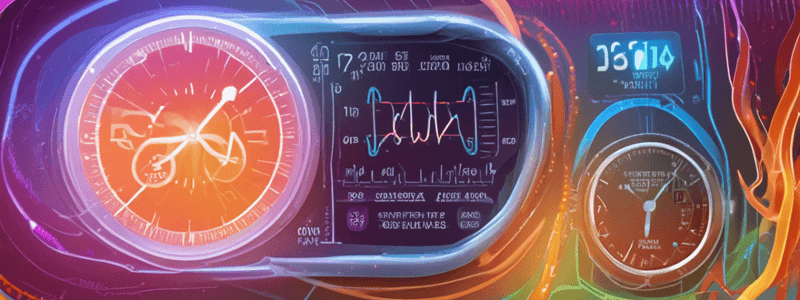Podcast
Questions and Answers
What are the four main vital signs routinely monitored by medical professionals and health care providers?
What are the four main vital signs routinely monitored by medical professionals and health care providers?
- Body temperature, pulse rate, respiration rate, and blood flow
- Body temperature, blood pressure, heart rate, and respiration rate (correct)
- Body temperature, blood pressure, heart rate, and blood sugar level
- Body temperature, blood pressure, heart rate, and body weight
What is the normal range for body temperature in a healthy adult?
What is the normal range for body temperature in a healthy adult?
- 97.8°F (36.5°C) to 99.0°F (37.2°C) (correct)
- 99.5°F (37.5°C) to 101.3°F (38.5°C)
- 95.0°F (35.0°C) to 97.6°F (36.4°C)
- 98.6°F (37.0°C) to 100.4°F (38.0°C)
How much higher is a rectal temperature compared to an oral temperature?
How much higher is a rectal temperature compared to an oral temperature?
- 0.2°C (0.36°F) higher
- 0.5°C (0.9°F) higher (correct)
- 0.3°C (0.54°F) higher
- 0.7°C (1.26°F) higher
How much lower is an axillary (underarm) temperature compared to an oral temperature?
How much lower is an axillary (underarm) temperature compared to an oral temperature?
Where can vital signs be measured?
Where can vital signs be measured?
What factors can affect a person's normal body temperature?
What factors can affect a person's normal body temperature?
Which of the following is not a way to measure body temperature?
Which of the following is not a way to measure body temperature?
What is the purpose of monitoring vital signs?
What is the purpose of monitoring vital signs?
Which of the following is not considered one of the four main vital signs?
Which of the following is not considered one of the four main vital signs?
What is the purpose of measuring body temperature?
What is the purpose of measuring body temperature?
What is the cause of pallor that may be due to vasoconstriction or endocrine disease?
What is the cause of pallor that may be due to vasoconstriction or endocrine disease?
Which type of cyanosis presents as blue coloration in the lips and tongue?
Which type of cyanosis presents as blue coloration in the lips and tongue?
What are the four criteria that confirm clubbing of nails?
What are the four criteria that confirm clubbing of nails?
What type of diseases can cause clubbing of nails?
What type of diseases can cause clubbing of nails?
Localized edema is typically due to which of the following?
Localized edema is typically due to which of the following?
Which sign is characteristic of lymphedema and myxedema but absent in other types of edema?
Which sign is characteristic of lymphedema and myxedema but absent in other types of edema?
Where are the epitrochlear glands located?
Where are the epitrochlear glands located?
What is one feature of pathological lymph nodes that often indicates infection?
What is one feature of pathological lymph nodes that often indicates infection?
What does fixation of lymph nodes to deep structures or skin usually indicate?
What does fixation of lymph nodes to deep structures or skin usually indicate?
What is the primary cause of generalized edema due to an increase in interstitial fluid?
What is the primary cause of generalized edema due to an increase in interstitial fluid?
What does a special thermometer measure in the ear?
What does a special thermometer measure in the ear?
How is a fever defined according to the American Academy of Family Physicians?
How is a fever defined according to the American Academy of Family Physicians?
What is hypothermia defined as?
What is hypothermia defined as?
What is the normal pulse rate range for healthy adults at rest?
What is the normal pulse rate range for healthy adults at rest?
What can an increased pulse rate indicate?
What can an increased pulse rate indicate?
How is the pulse rate measured?
How is the pulse rate measured?
What is the respiration rate?
What is the respiration rate?
What is blood pressure a measurement of?
What is blood pressure a measurement of?
What does the systolic pressure represent?
What does the systolic pressure represent?
What should you do before measuring your blood pressure?
What should you do before measuring your blood pressure?
What is the purpose of placing the stethoscope over the medial border of the biceps (brachial artery) during blood pressure measurement?
What is the purpose of placing the stethoscope over the medial border of the biceps (brachial artery) during blood pressure measurement?
What is the significance of oxygen saturation measurement?
What is the significance of oxygen saturation measurement?
Which of the following is NOT part of the physical examination process?
Which of the following is NOT part of the physical examination process?
What does the acronym JACCOL stand for in the physical examination?
What does the acronym JACCOL stand for in the physical examination?
What does the presence of a 'moon face' indicate during the physical examination?
What does the presence of a 'moon face' indicate during the physical examination?
What does the presence of a 'sweetness of breath' odor suggest during the physical examination?
What does the presence of a 'sweetness of breath' odor suggest during the physical examination?
What does a 'shuffling gait' indicate during the physical examination?
What does a 'shuffling gait' indicate during the physical examination?
What does the presence of 'splinter hemorrhages' in the nails suggest during the physical examination?
What does the presence of 'splinter hemorrhages' in the nails suggest during the physical examination?
What is the purpose of auscultating the thyroid gland during the physical examination?
What is the purpose of auscultating the thyroid gland during the physical examination?
What does the presence of jaundice indicate during the physical examination?
What does the presence of jaundice indicate during the physical examination?
Flashcards are hidden until you start studying




